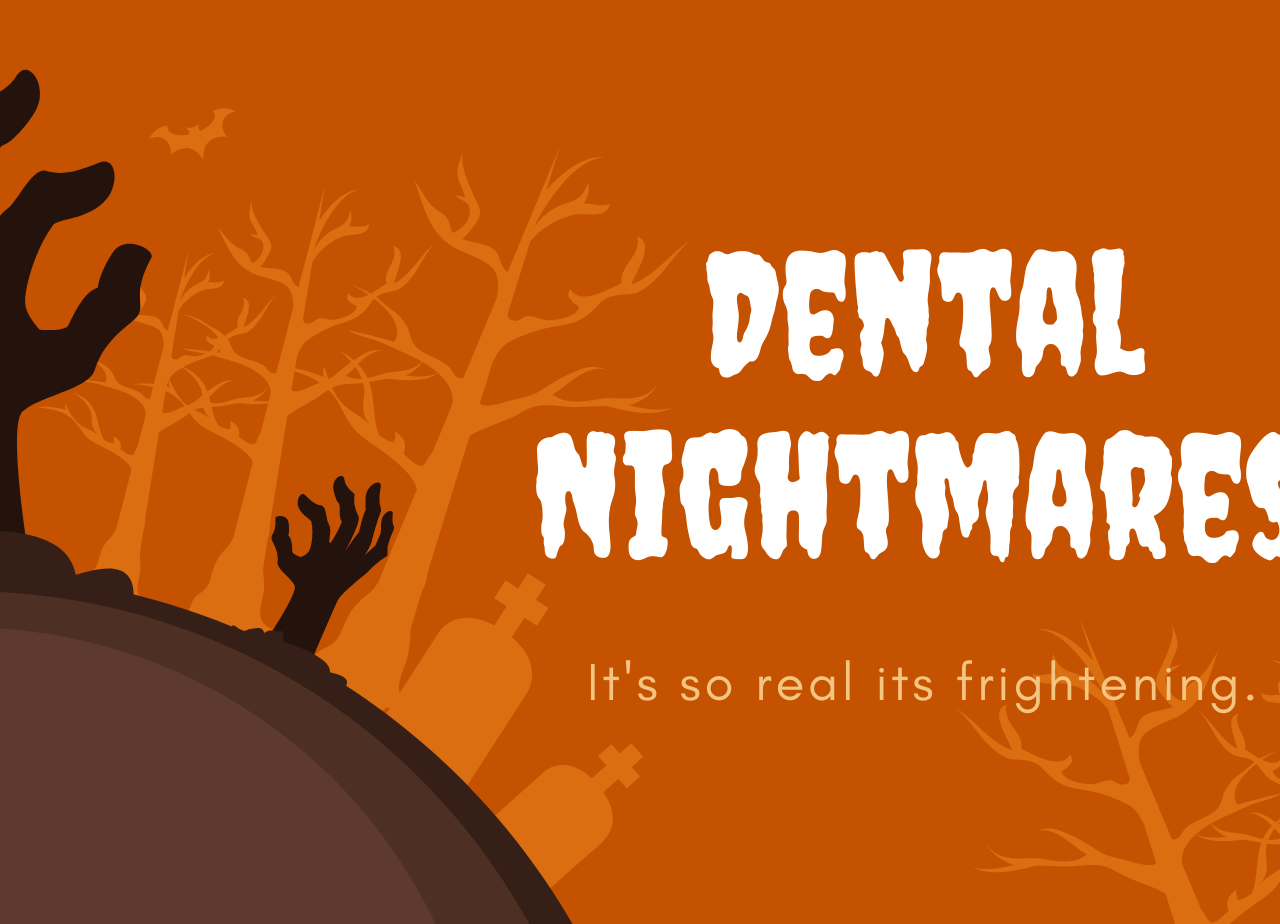Dental Nightmares

Welcome to your worst nightmare, from scary to embarrassing, we have it all. Hear from these well known dental clinicians about their worst dental nightmares.
Sticky Tales of Halloween Candy
By: Dr. Michael Miyasaki
It happens to the nicest of our patients. The one who has a tooth that we have done dental heroics on because of a lack of any tooth structure. With crown in hand they tell us the last piece of white bread (they always emphasize ‘soft’ white bread or Halloween candy they had) caused their tooth to come out.
Today I had an eighty-year-old patient call me. Her three-unit anterior bridge from teeth #7-9 came out as she was eating a piece of bread. Actually, the teeth fractured right at the level of the bone. No way to save them and too expensive for her to boot. Without that bridge she was left with only one other tooth, crowned it is, #6. When she smiled today, she said she was ready for Halloween. Thank goodness for her good humor and COVID face masking.
Getting Ghosted
By: Dr. Joshua Austin
The year was 2014. I would wear actual business casual clothing to the office, which was the style at the time. No one had ever heard of an N95 mask or SARS-COV-2. Donald Trump was just some guy on TV. Life was good. Or was it? You see, I am obsessive about post op visits. I HATE them. I hate them for a few different reasons.
Firstly, they make me feel like a crappy dentist. I know that every restorative dentist has post op issues of some sort, but they really take a toll on my self esteem and my mental health.
Secondly, they cost me money. Between my time, an assistant’s time, and disposables, a post op visit can cost me as much as $100. That sucks. Post ops eat profitability. They eat it fast.
Because of this post-op-o-phobia, I track my post ops closely. I do this by creating codes in my software for different post op visits. We have a code for a post op for a direct restoration (PODR is what we call it.) We have a code for a post op on an indirect restoration (POIR). We also have POEX for extractions, POEN for endo and POO for any other assorted procedures. I know…it spells poo. Don’t think I didn’t know that and chuckle when I made it. I made POO. HA! Still funny! But alas, this is Halloween, so this is supposed to be scary!
I have been tracking my post ops since I opened my practice 11 years ago. Generally speaking, my post ops for direct restorations range between 3-6% per month. That means that for every 100 direct restorations I do, I might see between 3-6 back for a post op issue. There is no industry wide standard for this because no one tracks this like I do, so I can anecdotally assume that this is an average number. One particular month….June of 2014….that number jumped to 47%. Yeah, this story just got scary didn’t it? WHAT THE HELL HAPPENED IN MAY AND JUNE OF 2014? I had no idea, but with a number like that, I knew I needed to find out.
I changed my pants, then got to work. I tried to work through the problem logically. Obviously, something was broken in my system. The only way to figure out what was to test each component. I started with my handpieces. I called Patterson Repair to come out and evaluate my handpieces and electric motors. I wanted to make sure they were running correctly and properly lubricated. I wanted to fine out if everything was being done properly maintenance wise. Maybe we were over oiling them so they were bathing the teeth with lubricant (giggity giggity) while I prepped. They came back with a clean bill of health.
Next I checked my etch. I called the manufacturer and gave them the lot number of my most recent bottle and asked if they had any issues reported. All clear. I even took some etch to an extracted tooth to see if it was working properly. I did the same with the adhesive and composite that we routinely use. Everything checked out fine.
Last thing I checked was my curing light. It had always been working properly. It turned on and off with no issue. It put out blue light, just like it should. All should have been right with the world. As a last ditch effort, I purchased a radiometer to fully check my light. I put the light on the radiometer and turned it on. The radiometer said 121 mW/CM2 of power was being emitted. Was that good? Was that bad? I didn’t know. I pulled up the directions for use of my curing light to check.
Oh. Well, it says in the DFU that my curing light should be emitting 1200 mW/CM2 of power. That doesn’t seem right! I called tech support of the company who made the light. They started walking me through the trouble shooting. First thing they asked me was “Is blue light coming out of the light like normal?” Yep. Exactly like normal. No difference. Next they asked me to see if any composite was caked on the end of the light guide. There was none there, but there was some composite stuck to the side of the light guide, at what I would call the hozzle. That is a golf term…where the head of the golf club meets with the shaft. The hozzle of a light guide is where the light guide meets with the actual curing light. How on earth could composite get way up there? I started flicking at it with my thumbnail and after a few passes, the entire light guide came off in my hand! Houston, we have a problem!
As I was telling the tech support representative about what happened, one of my dental assistants walked into my office and stood in the doorway. I covered up the microphone on my phone as I told her to take a hike “I’M ON THE PHONE!” She mouthed the words “I need to talk to you about that.” I politely asked Mr. Tech Support to hold please!
“Please, tell me all about this.” I said to her.
She then embarks on story like a teenager tells when they are out past curfew. She was working in the lab a few weeks ago when I was out of the office on a Friday like the valuable employee she is. She was making bleaching trays and spotted a bubble in a cast. It was a cast poured by another assistant. She was emphatic about that detail. She got some of the blue light cured block out resin to patch that hole in the cast before making bleaching trays. Before she knew it, the curing light had rolled onto the floor and the light guide broke off. She panicked. She thought the curing light was done-zo. She knew I would be angry about having to spend $1500 on a new curing light. She thought on her feet…”Why don’t I try gluing this thing back together.”
So thats what she did. And it worked! At least sort of. Blue light came out of the light. In her mind, it was fixed. What she didn’t understand was that output power and curing spectrum are vitally important to curing composite well and the super glued curing light had no chance of curing composite 5mm deep in a proximal box. Since the light worked as normal to the naked eye and I didn’t know about the broken light guide, I had no reason to think anything was wrong. I went about my merry way for over a month with a curing light only operating at 10% power. No wonder I had 47% post op issues….nothing was cured underneath the top layer of composite.
Here are some lessons we learned from this experience….
- My assistant learned that only the light guide broke, not the curing light itself. A new light guide for this light was $100.
- The cover up is always worse than the crime. If my assistant had been honest and forthcoming with me, we could have avoided A LOT of post op visits
- I need to be regularly testing my curing lights to make sure they are working correctly. We can not rely on our naked eye for this. We have since instituted weekly checks with a radiometer for all of our curing lights
I replaced over 100 direct restorations and 18 crowns that were done during that time. That is the true horror story here. That was not a practice builder. It was bad for everyone. Patients had to come back and be re-anesthetized for a mistake that could have been avoided. I spent hours re-doing work that I didn’t need to do which lead to THOUSANDS of dollars of lost production and time.
My advice on how to avoid this is simple and two fold. First…invest in a great curing light. Second….check it every week to make sure it is working well.
Let my horror be a lesson to us all!


